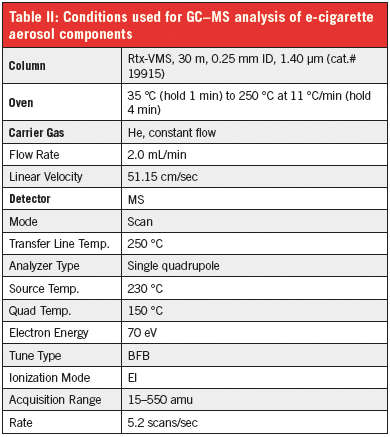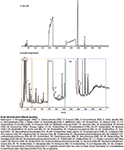New Method for Sampling and Analysis of Electronic Cigarette Aerosols
Special Issues
Following sampling, tubes were transferred to a Markes UNITY™ thermal desorption system paired with an Agilent 7890B GC that was coupled to an Agilent 5977A MS detector. The UNITY™ system and GC–MS parameters are presented in Table I and Table II, respectively.
Despite the growing popularity of electronic cigarettes, relatively little work has been done to characterize their aerosols. In this study, we developed a quick, simple device for sampling electronic cigarette aerosol onto thermal desorption tubes. This novel sampling approach-paired with an Rtx®-VMS column and GC–MS analysis-provides detectable levels of volatile organic compounds (VOCs) and semivolatile organic compounds (SVOCs) from a single 40 mL puff.
Most electronic cigarette (e-cigarette) research to date has focused on the composition of the e-cigarette liquid; however, users ultimately are exposed to the aerosol. Only a few researchers (e.g., Goniewicz et al. [1], Kosmider [2], and Schober et al. [3]) have attempted to characterize e-cigarette aerosol composition, but their study designs have been relatively complex and/or required the use of specialized smoking machines and/or an array of specialized analytical instruments. Such requirements often are not practical for small laboratories and/or contract testing. The current study introduces a novel technique that pairs straightforward thermal desorption sampling with GC–MS analysis using an Rtx®-VMS column. This approach provides a simple, practical method for evaluating the volatile organic compounds (VOCs) and semivolatile organic compounds (SVOCs) present in e-cigarette aerosol.
Experimental
In order to provide reproducible and quantitative results, a simple sampling device was adapted from a 50 mL gas-tight syringe (cat.# 24761). The syringe was used to draw 40 mL of aerosol in ~4 s from e-cigarettes across a stainless steel thermal desorption tube packed with Tenax TA, Carbograph TD, and Carboxen 1003 (unconditioned [cat.# 26469] or conditioned [cat.# 26470]). This tube was chosen because the combination of sorbents is optimal for screening VOCs in the C2-3 range up to SVOCs in the C30-32 range. The assembled sampling apparatus is shown in Figure 1.

Figure 1: A gas-tight syringe and thermal desorption tube assembly provided a simple method for quantitative sampling of electronic cigarette aerosols.
Following sampling, tubes were transferred to a Markes UNITY™ thermal desorption system paired with an Agilent 7890B GC that was coupled to an Agilent 5977A MS detector. The UNITY™ system and GC–MS parameters are presented in Table I and Table II, respectively.

Table I: Thermal desorption parameters used for extraction of the e-cigarette aerosol
Results
While the e-cigarettes solutions were labeled as containing propylene glycol, glycerin, and nicotine, the aerosol to which users are exposed is far more complex. As shown in Figure 2, numerous VOC and SVOC compounds (82 unidentified and identified [some only tentatively]) are present at detectable levels in the 40 mL aerosol sample. The presence of formaldehyde, acetaldehyde, acrolein, and xylenes, as well as several siloxanes is particularly notable, as these compounds have human health implications. For example, all three carbonyls (formaldehyde, acetaldehyde, and acrolein) are acutely toxic. In addition, formaldehyde is a known human carcinogen (4) and acetaldehyde is a probable human carcinogen (5). These compounds were not present in the e-cigarette solutions that were also analyzed (data available at www.restek.com in application note FFAN2127), indicating that they were generated during the aerosolization process and/or from the e-cigarette materials. This is consistent with the fact that pyrolysis of glycerin results in the formation of formaldehyde, acetaldehyde, and acrolein. This is also consistent with the fact that polysiloxanes are often used as plastic additives and the majority of the first generation e-cigarettes, like those evaluated in this study, are made with plastic bodies.

Table II: Conditions used for GC-MS analysis of e-cigarette aerosol components
Conclusions
Here, we present a novel approach using a thermal desorption tube to sample e-cigarette aerosols and an Rtx®-VMS column for GC–MS analysis. This technique provided detectable levels of 82 VOCs and SVOCs from a single 40 mL puff and can be easily implemented by laboratories that do not have access to a smoking machine. As the compounds found in this study have potential human health implications, more emphasis should be placed on aerosol analysis in order to better define the chemical profile and to determine how typical usage patterns relate to exposure limits.

Figure 2: A single 40 mL puff of electronic cigarette aerosol collected on a thermal desorption tube and analyzed on an Rtx®-VMS column via GC-MS.
For the complete version of this application-including evaluation of nicotine content and impurities in e-cigarette solutions-visit www.restek.com and enter FFAN2127 in the search.
References
(1) M.L. Goniewicz, J. Knysak, M. Gawron, L. Kosmider, A. Sobczak, J. Kurek, A. Prokopowicz, M. Jablonska-Czapla, C. Rosik-Dulewska, C. Havel, P. Jacob III, and N. Benowitz, "Levels of selected carcinogens and toxicants in vapour from electronic cigarettes," Tob. Control23, 133 (2014).
(2) L. Kosmider, A. Sobczak, M. Fik, J. Knysak, M. Zaciera, J. Kurek, and M.L. Goniewicz, "Carbonyl compounds in electronic cigarette vapors: effects of nicotine solvent and battery output voltage," Nicotine Tob. Res.16, 1319 (2014).
(3) W. Schober, K. Szendrei, W. Matzen, H. Osiander-Fuchs, D. Heitmann, T. Schettgen, R.A. Jorres, and H. Fromme, "Use of electronic cigarettes (e-cigarettes) impairs indoor air quality and increases FeNO levels of e-cigarette consumers," Int. J. Hyg. Environ. Health217, 628 (2014).
(4) V.J. Cogliano, Y. Grosse, R.A. Baan, K. Straif, M.B. Secretan, and F. El Ghissassi, "Meeting report: summary of IARC monographs on formaldehyde, 2-butoxyethanol, and 1-tert-butoxy-2-propanol," Environ. Health Perspect.113, 1205 (2005).
(5) IARC Working Group Lyon, 13-20 October 1987, Alcohol drinking, IARC Monogr. Eval. Carcinog. Risks Hum.44, 1(1988).

Restek Corporation
110 Benner Circle, Bellefonte, PA 16823
tel. (800) 356-1688, fax (814) 353-1309
Website: www.restek.com


.png&w=3840&q=75)

.png&w=3840&q=75)



.png&w=3840&q=75)



.png&w=3840&q=75)












